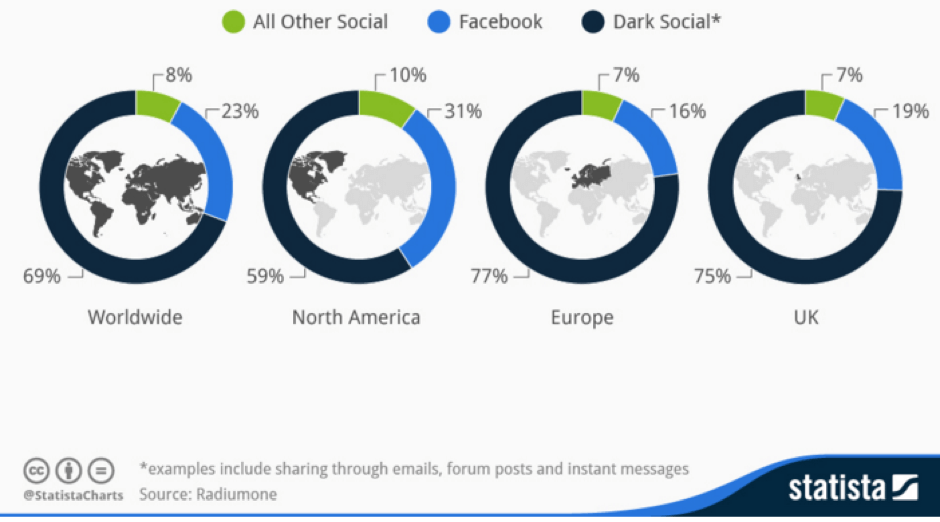
Navigate an unpredictable landscape with actionable, data-driven strategies tailored for your business from the brand down to the local level.

‘Dark social’ implies something rather intriguing and sinister doesn’t it? If you’re not familiar with the term I hate to disappoint, but put simply, in the world of online marketing it refers to social link sharing which happens privately and cannot be tracked.
It’s a trend online marketers need to get on top of, if they haven’t already, as it’s growing in prevalence. When it comes to online marketing, be it programmatic advertising, paid search or sponsored native content, for example, marketers are continually seeking to measure the impact of their activity, to see if it’s paid off. Through web analytics they track where referrals have come from, in order to judge the impact of various channels on conversions in particular.
Dark social comes into play here as it appears an increasingly high volume of link shares cannot be accurately tracked or attributed. The reason for this is that individuals are showing preference for sharing links privately, via social messaging apps such as Facebook Messenger, WhatsApp and Snapchat, as well as more traditional channels such as email and SMS.

Since the shares are taking place through secure communications channels, mainly via copy and paste, there is no visible referring link for the marketer. So when the recipient of the link chooses to click on it, it will show up as a direct link, and not a referral, which is a bit misleading and not strictly the case. Direct traffic typically refers to a user manually typing a URL into the address bar, and visiting first hand, whereas with dark social, individuals are generally visiting sites through second hand links which have been recommended. In effect, dark social is word-of-mouth advertising.
Secure browsing is another explanation for the rise in dark social. If a user clicks from HTTPS to HTTP the referrer won’t be passed on.
According to a study by programmatic ad buying platform RadiumOne, dark social represents around 75% of all sharing activity within the UK. That’s an awful lot of traffic for marketers to be lacking insight on.

With the increased usage of private messaging, via social channels and apps, dark social seems only likely to get bigger, and this missing data is likely to skew customer data significantly. When you consider dark social within this context, it could be have a sizeable impact on the ability of a marketer to plan a campaign, or decide which channels are the most effective. They could end up wasting time and money on optimising the wrong channels.
What’s more is that dark social is the leading sharing method in 19 major content categories. This includes many that are important to advertisers such as travel, personal finance, technology and automotive.
The same RadiumOne study mentioned above finds that as much as 36% of all dark social sharing takes place on mobile devices. This is happening through email and text messages, as well as social media like Facebook and Instagram, and other native mobile apps. This means a significant amount of mobile traffic to brand or business sites is getting categorised as direct traffic, hugely clouding the impact of mobile for referrals. Finding ways to more accurately track mobile link clickthroughs is only going to escalate in importance.
Subscribe to our monthly newsletter.
Although it requires a little more effort, there are ways and means to begin trying to measure dark social, if you aren’t already. Here are some tips to help get you started…
Conversations around dark social are heating up, and it seems only likely that more tools and techniques will emerge. Don’t fall into the trap of ruling it out as a space that can’t be measured. It can if you’re clever about things!
Navigate an unpredictable landscape with actionable, data-driven strategies tailored for your business from the brand down to the local level.
Navigate an unpredictable landscape with actionable, data-driven strategies tailored for your business from the brand down to the local level.
Navigate an unpredictable landscape with actionable, data-driven strategies tailored for your business from the brand down to the local level.
Subscribe to our monthly newsletter.